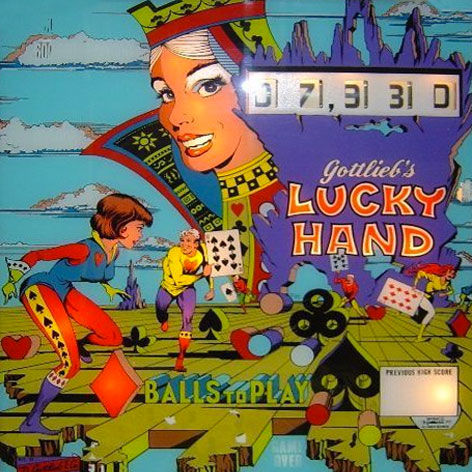-
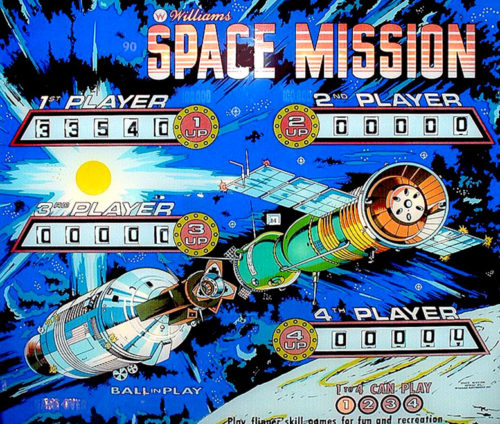 Space Mission was released in January, designed by Steve Kordek with artwork by Christian Marche. Production run was 11,652. This game was very successful for Williams and is considered to be the seventh most desirable game of the ’70s era.The game features a moving target as well as two side kickers next to the flippers for shots at the moving target. Making the A, B, or C light up the side eject holes to award a double bonus for the ball in play. If you were skillful enough to complete the A, B and C, the side outlanes light up for special. The top horshoe loop advances the bonus system. This game has a lot of nice shots and is fast paced. One doesn’t tire easily trying to achieve the scores needed to win a free game. This game was one of Steve’s Kordek’s favorite designs.
Space Mission was released in January, designed by Steve Kordek with artwork by Christian Marche. Production run was 11,652. This game was very successful for Williams and is considered to be the seventh most desirable game of the ’70s era.The game features a moving target as well as two side kickers next to the flippers for shots at the moving target. Making the A, B, or C light up the side eject holes to award a double bonus for the ball in play. If you were skillful enough to complete the A, B and C, the side outlanes light up for special. The top horshoe loop advances the bonus system. This game has a lot of nice shots and is fast paced. One doesn’t tire easily trying to achieve the scores needed to win a free game. This game was one of Steve’s Kordek’s favorite designs. -
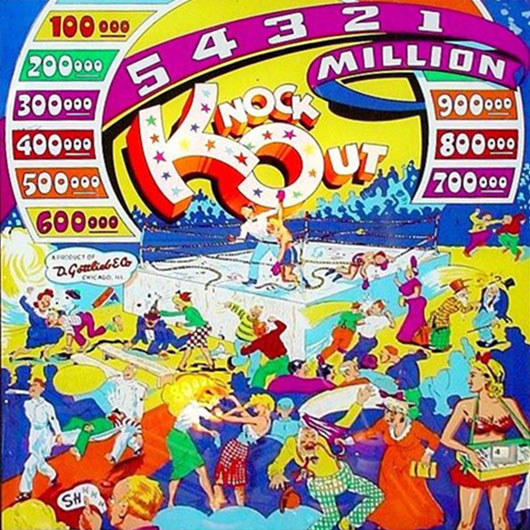 This game was produced in December of the year and designed by Harry Mabs with artwork by Roy Parker. 3,000 of these machines were made. The unique feature built into this machine is the animation unit in the top center of the play field. Two mechanical men are represented as boxers in a boxing match. Lights illuminate the bout when a knockout is scored by rolling over a “KO” rollover, a “KO” target, or completing bumpers 1 to 5. This game is one of the first examples of pinball animation. Another feature of the game is the pop-up bar at the bottom of the play field, preventing you from losing your ball in play for an extended period. Since the gap between the flippers is so massive, this addendum to the play field was installed to prolong the play period of the ball. A special feature is included in the game as well as a replay if 15 knockdowns are scored in one game and a replay for every knockdown scored thereafter.
This game was produced in December of the year and designed by Harry Mabs with artwork by Roy Parker. 3,000 of these machines were made. The unique feature built into this machine is the animation unit in the top center of the play field. Two mechanical men are represented as boxers in a boxing match. Lights illuminate the bout when a knockout is scored by rolling over a “KO” rollover, a “KO” target, or completing bumpers 1 to 5. This game is one of the first examples of pinball animation. Another feature of the game is the pop-up bar at the bottom of the play field, preventing you from losing your ball in play for an extended period. Since the gap between the flippers is so massive, this addendum to the play field was installed to prolong the play period of the ball. A special feature is included in the game as well as a replay if 15 knockdowns are scored in one game and a replay for every knockdown scored thereafter. -
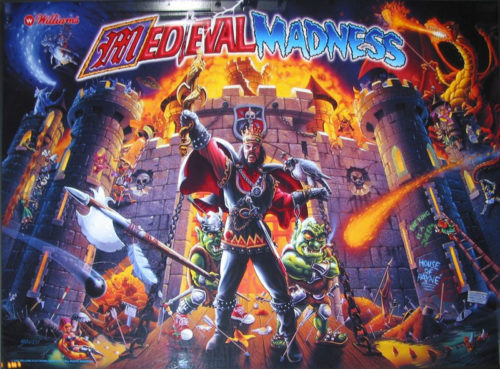 Flippers (2), Pop bumpers (3), Ramps (2), Autoplunger. A left-side catapult propels ball airborne into a habitrail. Two pop-up trolls in playfield become active during “Trolls!” mode. Tina Fey (of “Saturday Night Live” fame) did the voices of the “Opera Singer” princess and the Cockney-talking princess, and Andrea Farrell did the voices of the Jewish princess and the sexy princess. Greg Freres was the voice of the jousting announcer and one of the trolls while Francois Du Grim was voiced by Vince Pontarelli who also did the other troll. Look no further! This game, in my humble opinion, takes the prize as the most sought-after, inventive game of the ‘90s! Brian Eddy designed this machine with 4,016 units screwed together. The action, endless vocal calls, the exploding castle, the pop-up trolls and the moat and dropping gate make this machine one of a kind. The value of this machine is going through the roof, more than doubling its original price. The six kings from six different castles must be defeated by attacking the castle walls. Defeating a king makes the fort collapse. It’s nearly impossible to complete this feat. The princess must be rescued up the upper right ramp when activated (the princess’s vocals are none other than Tina Fey’s voice). Many multiball challenges await. The trolls must be hit many times to be conquered. The whole package is artistically and musically amazing. Most of these machines are tucked away in home arcades at this point. Enjoy!
Flippers (2), Pop bumpers (3), Ramps (2), Autoplunger. A left-side catapult propels ball airborne into a habitrail. Two pop-up trolls in playfield become active during “Trolls!” mode. Tina Fey (of “Saturday Night Live” fame) did the voices of the “Opera Singer” princess and the Cockney-talking princess, and Andrea Farrell did the voices of the Jewish princess and the sexy princess. Greg Freres was the voice of the jousting announcer and one of the trolls while Francois Du Grim was voiced by Vince Pontarelli who also did the other troll. Look no further! This game, in my humble opinion, takes the prize as the most sought-after, inventive game of the ‘90s! Brian Eddy designed this machine with 4,016 units screwed together. The action, endless vocal calls, the exploding castle, the pop-up trolls and the moat and dropping gate make this machine one of a kind. The value of this machine is going through the roof, more than doubling its original price. The six kings from six different castles must be defeated by attacking the castle walls. Defeating a king makes the fort collapse. It’s nearly impossible to complete this feat. The princess must be rescued up the upper right ramp when activated (the princess’s vocals are none other than Tina Fey’s voice). Many multiball challenges await. The trolls must be hit many times to be conquered. The whole package is artistically and musically amazing. Most of these machines are tucked away in home arcades at this point. Enjoy! -
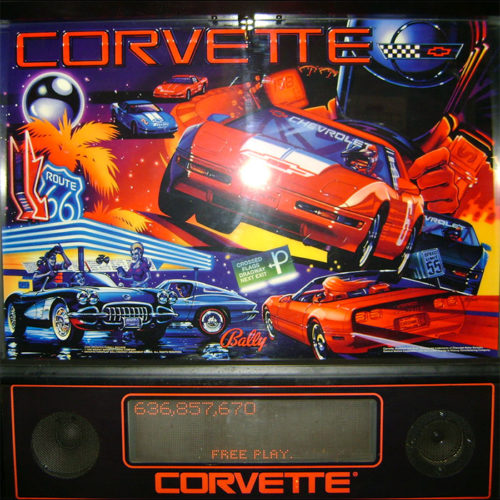
-
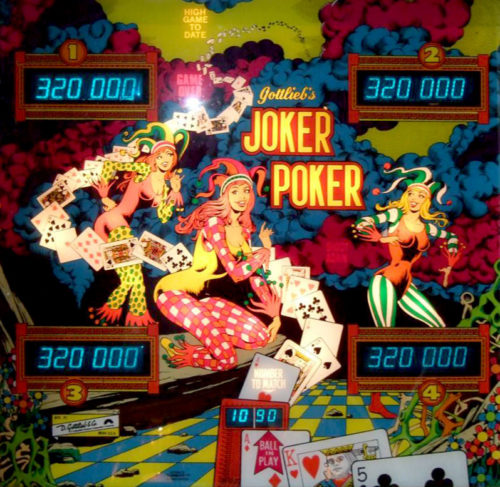 Gottlieb Joker Poker pinball. An interesting design, and only made in a 4 player version (no 2 player, unusual for Gottlieb pinball). One bank of five ace drop targets, one bank of four king drop targets, one bank of three jack targets, one bank of two queen drop targets, and a single ten drop target. Pretty cool pinball design really. Two pop bumpers, one slingshot, two 3″ flippers. They made 820 Gottlieb EM Joker Poker pinballs.
Gottlieb Joker Poker pinball. An interesting design, and only made in a 4 player version (no 2 player, unusual for Gottlieb pinball). One bank of five ace drop targets, one bank of four king drop targets, one bank of three jack targets, one bank of two queen drop targets, and a single ten drop target. Pretty cool pinball design really. Two pop bumpers, one slingshot, two 3″ flippers. They made 820 Gottlieb EM Joker Poker pinballs. -
 Williams produced this game in October with 7,053 units produced. Norm Clark designed the game and Christian Marche did the art package. This four-player electromechanical game is based on the game tic-tac-toe. Making 3 x’s or 3 o’s in line or diagonally lights the eject holes to award an extra ball and 5,000 points. Making the A and B rollovers lights the center target. Hitting it opens the gate and 1,000 points. A bonus feature is incorporated into the game and this is awarded when the ball drains. Lighting all the squares activates the side rollover lanes to score a replay. Score and matching are also incorporated into the game. A fast playfield design and fun to play.
Williams produced this game in October with 7,053 units produced. Norm Clark designed the game and Christian Marche did the art package. This four-player electromechanical game is based on the game tic-tac-toe. Making 3 x’s or 3 o’s in line or diagonally lights the eject holes to award an extra ball and 5,000 points. Making the A and B rollovers lights the center target. Hitting it opens the gate and 1,000 points. A bonus feature is incorporated into the game and this is awarded when the ball drains. Lighting all the squares activates the side rollover lanes to score a replay. Score and matching are also incorporated into the game. A fast playfield design and fun to play. -
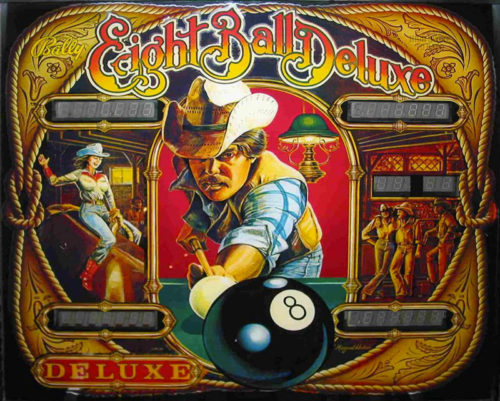 This game was very successful for the Bally company. It was initially released in 1981 as a full upright pinball with a production of 8,250 games. This version of the game in its third release had a run of 8,850 games. This cabinet was a unique design for Bally, as was used in a few other games like Pac-Man pinball. Designed by George Christian with art by Margaret Hudson, the pool-themed game is a classic. The basic object here is to hit all seven drop targets representing pool balls. The eight-ball drop target then pops up. Upon hitting it, “deluxe” lights up behind where the drop targets were. Making “deluxe” increases your bonus upon completion of the ball and advances the deluxe hold-over feature on the backglass. Hitting the in-line drop targets awards points and specials. The same is true if you shoot the left ramp to the top.
This game was very successful for the Bally company. It was initially released in 1981 as a full upright pinball with a production of 8,250 games. This version of the game in its third release had a run of 8,850 games. This cabinet was a unique design for Bally, as was used in a few other games like Pac-Man pinball. Designed by George Christian with art by Margaret Hudson, the pool-themed game is a classic. The basic object here is to hit all seven drop targets representing pool balls. The eight-ball drop target then pops up. Upon hitting it, “deluxe” lights up behind where the drop targets were. Making “deluxe” increases your bonus upon completion of the ball and advances the deluxe hold-over feature on the backglass. Hitting the in-line drop targets awards points and specials. The same is true if you shoot the left ramp to the top. -
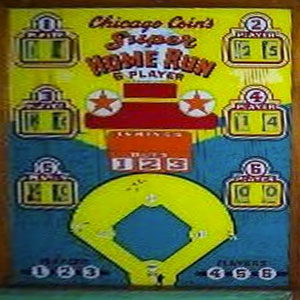
-
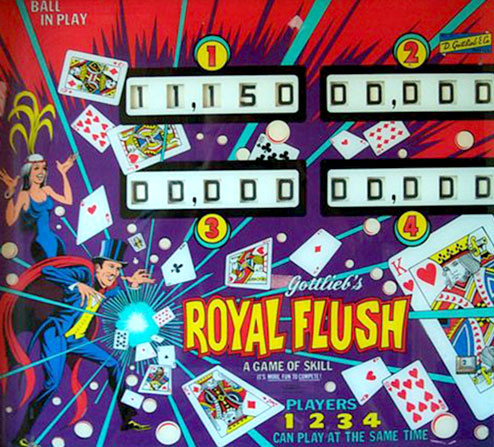 This April release came in a four-player version, also in the museum called “Royal Flush.” 12,250 games were created in this sizable run of machines. Ed Krynski designed the machine with Gordon Morison penning the artwork for the game. A very popular game in its day, the main ingredient of the play field is the battery of nine drop targets set at an angle. The object here is to complete the drop targets to complete the five card combinations represented on the front play field. Completing a combo illuminates the light in the bonus column of combos and at the end of the ball, a “scan” bonus would score the appropriate number of points to the player currently up. The drop targets reset after each ball unless an extra ball is scored via the free ball gate. A double scan of the bonus lights on the last ball. Another feature to shoot for is the three colored card sequence. These light a special on the kick-out hole.
This April release came in a four-player version, also in the museum called “Royal Flush.” 12,250 games were created in this sizable run of machines. Ed Krynski designed the machine with Gordon Morison penning the artwork for the game. A very popular game in its day, the main ingredient of the play field is the battery of nine drop targets set at an angle. The object here is to complete the drop targets to complete the five card combinations represented on the front play field. Completing a combo illuminates the light in the bonus column of combos and at the end of the ball, a “scan” bonus would score the appropriate number of points to the player currently up. The drop targets reset after each ball unless an extra ball is scored via the free ball gate. A double scan of the bonus lights on the last ball. Another feature to shoot for is the three colored card sequence. These light a special on the kick-out hole. -
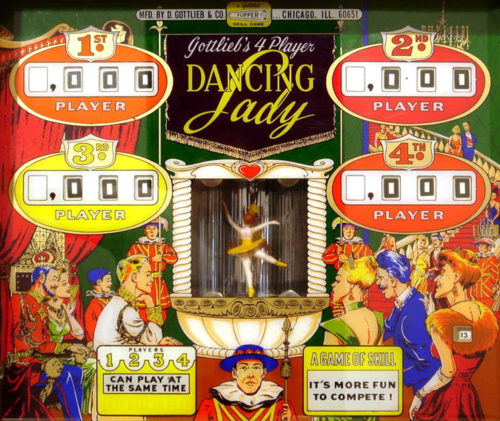 This four-player machine was produced in November of the year with 2,675 units fabricated. It was designed by Ed Krynski with art penned by Art Stenholm. Technically, a couple of firsts were incorporated into this machine for Gottlieb, like an automatic ball lifter, decagon score reels and carousel roto-targets. The carousel roto-target allow one to shoot at one or two targets at a time if flipper savvy. The star on the unit awards an extra ball. The object of the game is to achieve high-enough scores to award replays. The big points are awarded when the two 10x lights under a roto-target light up, awarding 100 times the value of the number hit. The most attractive gadget built into the game is the dancing ballerina in the backglass, which dances when certain elements of the play field are achieved. A highly collectible game in its own right.
This four-player machine was produced in November of the year with 2,675 units fabricated. It was designed by Ed Krynski with art penned by Art Stenholm. Technically, a couple of firsts were incorporated into this machine for Gottlieb, like an automatic ball lifter, decagon score reels and carousel roto-targets. The carousel roto-target allow one to shoot at one or two targets at a time if flipper savvy. The star on the unit awards an extra ball. The object of the game is to achieve high-enough scores to award replays. The big points are awarded when the two 10x lights under a roto-target light up, awarding 100 times the value of the number hit. The most attractive gadget built into the game is the dancing ballerina in the backglass, which dances when certain elements of the play field are achieved. A highly collectible game in its own right. -
 This “special edition” game was produced to recognize the fact that this game, when initially released two years earlier, was the biggest number production game ever made in the contemporary era, with a total production run of 20,270. This game was produced in 1,000 examples. Pat Lawlor designed the machine with John Youssi getting accolades for the artwork. Gadgets abound in this machine, which is augmented by the gold detailing over the standard unit. The main theme here is to complete all 12 parts of the house panel. Doing so brings you to the ultimate level of excitement. Multi-ball options abound as well as “Thing”, consisting of just a hand, grabbing the ball in the upper-right corner of the machine. A magnet under the play field provides strange ball play as well as Thing “flipping” the ball remotely if hit. The sounds and art are fantastic representations from the movie of the same name. This game is #3!
This “special edition” game was produced to recognize the fact that this game, when initially released two years earlier, was the biggest number production game ever made in the contemporary era, with a total production run of 20,270. This game was produced in 1,000 examples. Pat Lawlor designed the machine with John Youssi getting accolades for the artwork. Gadgets abound in this machine, which is augmented by the gold detailing over the standard unit. The main theme here is to complete all 12 parts of the house panel. Doing so brings you to the ultimate level of excitement. Multi-ball options abound as well as “Thing”, consisting of just a hand, grabbing the ball in the upper-right corner of the machine. A magnet under the play field provides strange ball play as well as Thing “flipping” the ball remotely if hit. The sounds and art are fantastic representations from the movie of the same name. This game is #3! -
